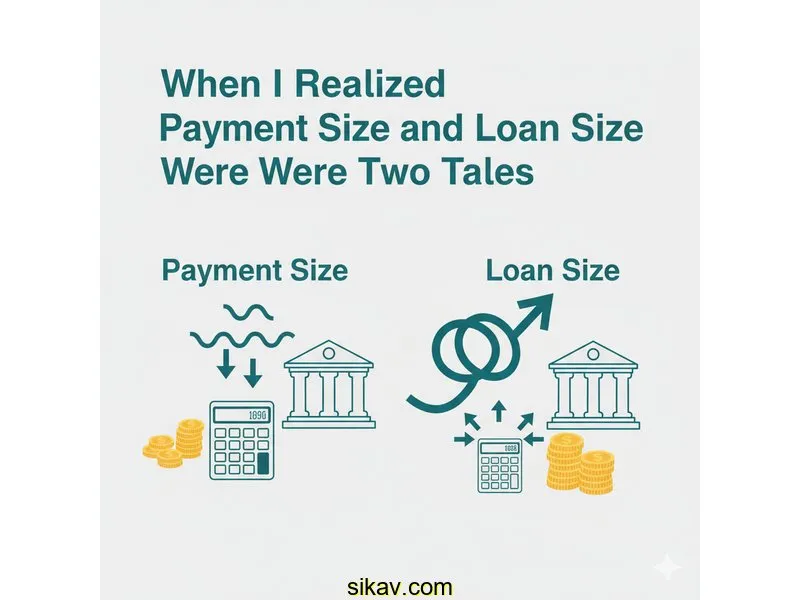
Auto Loan Calculator
Calculate payments over the life of your Loan
Home Blog Privacy Terms About Contact
Calculate payments over the life of your Loan
Home Blog Privacy Terms About ContactPublished on October 15, 2025

My journey into the world of loan math began with a simple project: setting up a small home recording studio. I had a specific amount in mind, $11,750, to cover the essentials. As I started exploring online loan calculators to understand the numbers, I found myself immediately drawn to one specific field: the monthly payment. It felt like the most important piece of information, the one number that would determine if something was manageable or not.
I wasn't trying to make a financial decision yet; I was just trying to learn. My goal was purely educational. I wanted to understand how the numbers on the screen were generated. I’d plug in the loan amount, an interest rate, and a term, and like magic, a monthly payment would appear. But the more I played with the inputs, the more a specific question started to form in my mind. Why did some options with appealingly low monthly payments seem to have shockingly high total repayment amounts?
How could a lower payment, something that felt objectively "cheaper" on a month-to-month basis, result in me paying more overall? What was the invisible math happening behind the scenes that I was missing? This wasn't about finding the "best" loan; it was about my personal quest to understand the mechanics. It was a puzzle, and the monthly payment number, which I initially thought was the answer, turned out to be just a single clue. This is the story of how I learned to read all the clues. Please remember, this is about understanding how calculations work, not financial advice.

My confusion solidified when I set up a direct comparison. Using a standard online loan calculator, I created two hypothetical scenarios for my $11,750 project. I kept the loan amount and the interest rate identical to isolate the variable that was tripping me up: the loan term. My only goal was to see how changing the number of months would alter the outcome.
Here were the two scenarios I put side-by-side:
The calculator instantly produced the results. Scenario A offered a monthly payment of around $242.04. My immediate reaction was positive; that number felt manageable and easy to picture. Then, I looked at Scenario B. Its monthly payment was significantly higher, around $372.43. My brain, hardwired to seek the lower number, immediately flagged Scenario A as the "better" one from a purely numerical standpoint.
But then my eyes drifted to another field on the calculator, one I had been mostly ignoring: "Total Interest Paid." This is where my understanding completely broke down. For Scenario A, with the lower monthly payment, the total interest paid was $2,772.40. For Scenario B, with the higher payment, the total interest was only $1,657.48. I stared at the screen, baffled. How on earth could the option that cost me more each month result in over $1,100 less in total interest? It felt like a contradiction. I was so focused on the monthly cash flow aspect that I had completely missed the bigger picture. I knew there was a fundamental principle of loan math that I just wasn't grasping.
Frustrated, I stepped away from the automated calculators and pulled out a simple digital notepad. I decided to forget the complex formulas for a moment and just focus on the most basic math I could think of. What was the total amount of money I would actually pay back in each scenario? I wrote down the simple equation: Monthly Payment × Number of Months = Total Repayment. This was the key I had been missing.
For Scenario A, I calculated: $242.04 × 60 months = $14,522.40. For Scenario B, I did the same: $372.43 × 36 months = $13,407.48. Suddenly, everything clicked into place. The "cheaper" monthly payment was an illusion created by stretching the payments over a much longer period. While each individual payment was smaller, there were 24 extra payments, and each of those payments contained interest. It was the duration, the term itself, that was the powerful multiplier I had overlooked.
My first major lesson was to stop seeing the loan term as a passive timeline. It's an active ingredient in the calculation. A 60-month term isn't just "five years"; it's a multiplier of 60. A 36-month term is a multiplier of 36. The smaller multiplier in Scenario B meant that the total payments had less room to grow, even though each individual payment was larger.
My second lesson was to elevate the "Total Interest Paid" field to the same level of importance as the monthly payment. I learned that these two numbers tell two different, but equally important, stories. The monthly payment tells the story of affordability and cash flow. The total interest tells the story of the overall mathematical expense. You can't understand the full picture without looking at both.
Finally, I learned how to connect these two stories with that simple multiplication. A loan calculator is a fantastic tool, but understanding the basic check—multiplying the payment by the term—gave me the confidence to know *why* the calculator was right. It wasn't magic anymore; it was just math I now understood.
To make sure this wasn't a fluke, I ran a completely different test. I imagined a hypothetical loan of $20,000 at 7.5%. First, I calculated it over 72 months, which resulted in a monthly payment of about $346 and total interest of nearly $5,000. Then, I ran it for 48 months. The payment jumped to about $484, but the total interest dropped to just over $3,200. The pattern held. The lower payment came with a higher overall interest figure, and I now understood exactly why.
This whole experience reshaped how I view loan calculators and the numbers they present. My goal was never to find the "best" product, but to achieve literacy in what the numbers were telling me. I feel much more equipped to do that now. Here are the core lessons I've taken away about the calculations themselves:
This was my central question. The answer is that interest is calculated on the outstanding balance. With a longer term and smaller monthly payments, the loan balance decreases more slowly. This means you are borrowing the money for a longer period, and interest is being applied to a higher average balance over that time, causing the total interest to add up to a larger number.
From my learning journey, the most effective way to compare the math is to look at three key numbers side-by-side for each option: the monthly payment, the loan term, and the total interest paid. This gives you a clear view of both the short-term impact on your budget (monthly payment) and the long-term overall expense (total interest).
Most good-quality online loan calculators will show this, but not all of them make it prominent. Sometimes you have to click a "details" or "view amortization schedule" button to find it. If a calculator doesn't show it, you can always calculate it yourself: multiply the monthly payment by the number of months in the term, then subtract the original loan amount from that total.
This was another discovery for me. On most standard loans, your early payments are heavily weighted toward paying off interest. As you continue to make payments and your principal balance shrinks, a larger portion of each subsequent payment goes toward the principal. An amortization schedule visually breaks this down month by month and is an incredibly educational tool.
My biggest takeaway from this entire process is that no single number in a loan calculation tells the whole story. I started this journey fixated on the monthly payment, believing it was the only number that mattered. I ended it realizing that it's just one chapter in a much larger book. The loan term, total interest, and total repayment are the other chapters, and you need to read them all to understand the plot.
I feel a genuine sense of empowerment from this. It's not about being a math wizard; it's about being curious enough to ask why the numbers are what they are. Playing with calculators, doing simple multiplication on the side, and seeing how one variable impacts another has demystified the process for me. I’d encourage anyone who feels intimidated by these calculations to simply start experimenting. Plug in different numbers and watch what happens. You might be surprised at the clarity you can achieve.
This article is about understanding calculations and using tools. For financial decisions, always consult a qualified financial professional.
Disclaimer: This article documents my personal journey learning about loan calculations and how to use financial calculators. This is educational content about understanding math and using tools—not financial advice. Actual loan terms, rates, and costs vary based on individual circumstances, creditworthiness, and lender policies. Calculator results are estimates for educational purposes. Always verify calculations with your lender and consult a qualified financial advisor before making any financial decisions.
